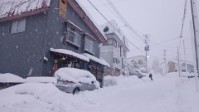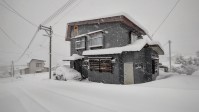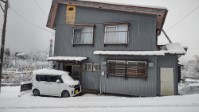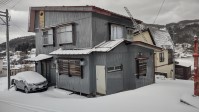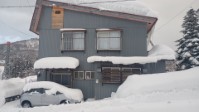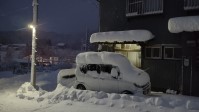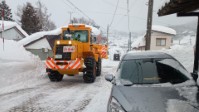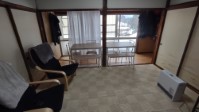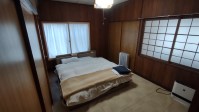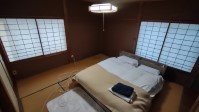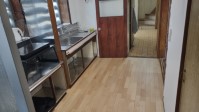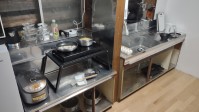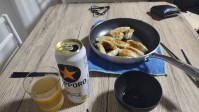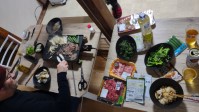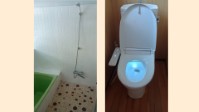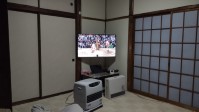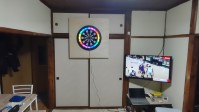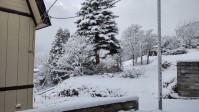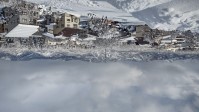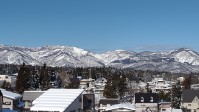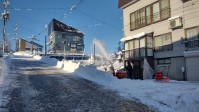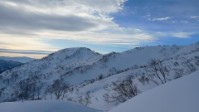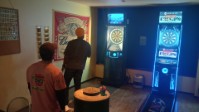About Arai Lodge
Where is it?
Situated in the little town of Nihongi Niigata, the house is a short 10 minute drive to Lotte Arai ski resort and just 20 minutes from Myoko Akakura.
How to get there?
Take the 2 hour Shinkansen from Tokyo to Jōetsumyōkō Station. Then drive 20 minutes south to the "lodge".
Gallery
Contact Us
Location:
1295-29 Nakagōku Nihongi
Joetsu, Niigata 949-2304 Japan
〒949-2304
新潟県
上越市
中郷区二本木
1295-29
Email:
info@arailodge.com
Information For Long Term Guests
Where to ski and snowboard?
Firstly, you will need a car. Any car with winter tyres and AWD will be fine.
Lotte Arai is an awesome resort although there is very limited runs for beginners. Lotte Arai is more expensive than the average Japanese resort but absolutely worth it on a powder day. Please never duck the ropes and always wait for ski patrol to open the gates. This mountain is just a 10 minute from Arai Lodge. You can see it from the upstairs windows :)
Mt. Myoko has 5 resorts. Suginohara is the furthest from Arai Lodge but it's my preference for a great day. Ikenotaira is best for avoiding the crowds and taking learners up the hill. Seki Onsen is tiny resort but a wild experience on a powder day. It has just 2 very old lifts with virtually no ski patrol or signs indicating dangers but that's the charm. Akakura Kanko and Akakura Onsen are bigger resorts but also more crowded. It's just 20 minutes drive to Kanko and parking is easy unless it's a Saturday.
Charmant Hiuchi is an hour drive away towards the sea and the roads are not the best after a snow storm but it's super cheap and very empty. A hidden gem for sure.
Nozawa Onsen and Madarao Kogen take around an hour drive during the winter ..... I strongly prefer Lotte Arai to those resorts but sometimes a change of scenery is nice.
Daily snow removal?
All of my neighbours own small snow blowers which they use on regular basis to clean their driveways. Since Arai Lodge does not have a driveway, we just use shovels in the morning to clear snow away from the front and side of the car. It does not take long.
Many streets in this area of Niigata have a built-in water sprinkler system which run the entire night so snow does not settle. Our street does not have this system, so instead, an extremely large snow plough will arrive early in the morning if more than 20cm of snow falls.
You will see many empty blocks of land around the house. In winter, these blocks are used to store snow until the council can arrive with dump trucks to take it away.
Fortunately, the house is situated off the mountain so removing snow from the roof is only required once per year at the most. The people that own houses within walking distance of the lifts need to spend an extraordinary amount of time clearing snow from their homes.
How many bedrooms?
The house has 4 good size bedrooms. 3 of which are "Japanese" style and 1 "western" style bedroom.
Car parking?
In summer time, the numerous empty blocks of land offer lots of parking spaces but in winter time, parking is limited to just the front carport. If you have a second car, then you can park it near the council building. Smaller cars are preferred to navigate the small streets.
Car rental recommendations?
Next to the Jōetsumyōkō shinkansen station there is 5 different rental companies. I always use Orix but the other companies are fine too. Just ensure you have snow tyres (aka studless) and all-wheel-drive.
Electricity utilities?
Payment for electricity is modern and easy. We use Octopus Energy and pay online via debit card.
The circuit breakers in the house will likely trip if you turn on 3 or more high power devices. Things like electric heaters or corded vacuums. Normal or low power devices will not cause any issue. We typically use the gas or kerosene heaters (which use minimal power) to warm up the house at the end of the day. If the circuit breaker trips, then it's easy to reset.
Water and sewage utilities?
This is operated by the local government. Without having a Japanese bank account, payment will need to be made using the QR code at any 7-Eleven.
Town gas utilities?
Town gas (aka natural gas) is joined together with the water service. So when the bill arrives in the mail, just take it to 7-Eleven to pay. In my experience, gas and water prices are very reasonable in Japan.
If there is a significant earthquake, then the gas will automatically shut off. Before you can turn it back on, you will need to shut off all gas outlets in the house and start the gas leak test. Once no leaks are detected, the gas can be turned back on.
What heaters are there?
There is a large Rinnai gas heater downstairs and a large gas heater upstairs. Both are brand new and very effective. In addition, there is 1 large kerosene heater which produces a lot of heat for very little burn. Filling the jerry can is cheap and easy, most petrol stations in the area offer self service kerosene. Be aware that you should not sleep with a kerosene heater on since it burns all the oxygen in the room. The heater will play music each hour to remind you to open the window briefly and push the "continue" button. The kerosene heater will turn itself off if you don't press the continue button when the music plays.
The house also has 2 new DeLonghi oil heaters which we use during the night while sleeping.
Finally, there are some small electric heaters which are good for heating the bathroom area.
Hot water?
The kitchen use a new small instant gas hot water system. Just press the big round button to turn it on and off. Temperature is adjusted by turning the dial.
Hot water for the laundry, bath and shower comes from a very powerful large instant gas heater. The control panel for this water tank is just above the bath. You only need to activate the hot water system one time after mains power is switched on. The control panel can "speak" in Japanese and warn you if you set the temperature at a particularly high level. The shower room has recently been painted.
Cold water?
In this area of Japan it's common to have frozen water pipes on very cold nights. To avoid this, go to the laundry and let the cold water drip slowly into the basin overnight. This only needs to be done on the coldest of nights. Typically only 5 or 6 times per season.
Garbage collection?
Compared to most countries, it's complicated in Japan. Sorting of garbage is taken seriously by most citizens. Each local community will have their own rules and procedures. In Nihongi, each house receives a calendar showing which day is the designated day for each of the garbage types (like bottles, food scrapes, cans, cardboard, plastic packaging etc). There is a collection point close to the house that opens each evening where you drop off the garbage. Some garbage (like food scraps and general burnable) require the purchase of specific biodegradable bags - the bags are cheap and easy to find at many stores. Arai Lodge is part of Joetsu city so be careful not to buy the Myoko city bags.
Cardboard milk cartons and cardboard juice cartons are not collected. They need to be taken to the supermarket and put in the sorting bins at the front. The same applies for plastic egg cartons.
Cooking breakfast, lunch and dinner?
The kitchen has all new appliances including induction cooker, rice cooker, sandwich press, multifunction convection oven and fridge/freezer.
What restaurants do you recommend?
For cheap meal, Michi-no-Eki Arai has a couple of Japanese restaurants near the Lawson convenience store.
食堂ミサ 道の駅あらい店 is popular with locals but only accept cash.
ラーメン翔道の駅あらい店 is good and cheap and has English menus.
There is also a bakery here but most items are sold before midday. There is a fish market here too. The pizza shop is closed more often than not and I personally do not love Japanese style pizza.
In Arai town there are some small places to eat.
Bar Don't is my favourite. No English and a very short menu but I love the yakitori here.
Yamato has fresh food but might require a booking.
旬菜酒房武相荘 sells big beers and ordering is via a tablet. Each table is enclosed in a tiny little room which is an unusual experience.
Kanzashi is a tiny mum & pop old style izakaya.
Ramen restaurant that doesn't have a google map mark but worth a visit.
Just near Akakura resort there are many restaurants at night however given the popularity of that region in the last few years, reservations are required for all of them.
Lotte Arai has Asahi. You need a booking and it's more expensive than a typical Niigata restaurant, but the dishes are super fresh and always amazing.
Grocery shopping?
There are 4 supermarkets nearby. If you went skiing at Myoko, then you'll drive past Narus on the way back home. If you were near Arai, then there are two Harashin here and here. There is also a larger Narus near the shinkansen station.
Meat and fish are cheap in these supermarkets. Fruit and vegetable in winter is average as you'd expect. The supermarkets have a full time kitchen that make fresh meals all day, ready to purchase and eat. From what I see, in this area of Japan, it's common to only buy a small amount of food and return to the supermarket several times per week.
In terms of hardware stores, there is a Power Komeri here, a smaller Komeri in Arai and also a Musashi on the Arai main road. These stores sell everything from power tools, timber, pet food, bikes, alcohol, rugs, heaters and everything in between.
The nearest convenience store is the Daily Yamazaki which is about 3 minutes away. There is a larger Lawson and 7-Eleven close by.
Washing clothes and linen?
The laundry has a large new washing machine with English translations on the control panel. Upstairs there is a typical Japanese sun room used for drying clothes on the drying racks.
Ski and snowboard waxing?
Please use the waxing room next to the kitchen. There is a new waxing iron and waxing stand permanently setup there. Be sure to wax your gear every 2 or 3 days. I typically buy bars of wax from the shops near the ticket desk at the resorts.
Earthquakes?
Minor earthquakes occur every day in Japan but significant earthquakes in Nihongi town are rare. Japan has sophisticated early warning systems and your mobile phone will alert you using the emergency warning system. It's good practice to keep a jacket, torch, water bottle and shoes near the front door in case you need to remove yourself from a house during an earthquake.
